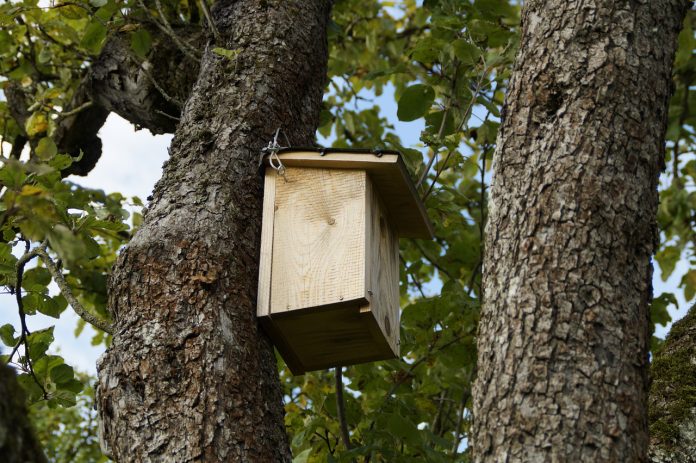Although cavity-nesting songbirds such as bluebirds and chickadees don’t begin nesting until late March or early April, the search for a suitable nest site has already begun.
Historically, cavity-nesters have nested in natural cavities and old woodpecker holes in trees and fence posts. When natural cavities are in short supply, these species often use man-made nest boxes.
There’s no time like the present to build or buy a few nest boxes. Here are some pointers for building a simple bird box. If you’re more inclined to buy a nest box at a nature center or wild bird store, these tips will help you recognize a quality product.
Material to use
A basic 4-inch by 4-inch by 12-inch box with a 1.5-inch diameter hole attracts eastern bluebirds, chickadees, titmice, nuthatches and wrens. Three-quarter inch exterior plywood or scrap lumber works well for building nest boxes — it’s inexpensive, easy to work, weathers well, and has a rustic look.
Thick wood insulates nests from spring chills and summer heat. The actual design and appearance of a nest box are unimportant to birds. All they need is protection from the elements and predators.
The security provided by a fancy birdhouse is no better than that found in a simple wooden box. Use rust-proof screws to assemble the box; they will increase the life of the box by several years.
If you must paint a nest box, use light colored earth tones. They absorb less heat and are less conspicuous to vandals.
Apply several coats to the roof; it receives the greatest exposure and weathers faster than the sides. Better yet, tack a shingle or two to the roof for even greater protection.
Points to consider. Do not paint the inside of the box — there’s no reason to expose eggs and naked chicks to potentially hazardous chemicals. Nest boxes should be emptied after each nesting cycle, so be sure the box is easy to open and clean.
Side or front-opening boxes work best. Position the top of the entrance hole about an inch below the top of the box. Keeping the hole high makes it more difficult for raccoons and other predators to reach in and raid the nest.
Unfortunately, cavity-nesters often fill the box with nesting material, so nests sometimes sit just below the hole. An extra thickness of wood placed directly over the entrance hole (with a matching hole, of course) serves as a predator guard by increasing the “reaching distance” between the nest and a predator.
A baffle around the post beneath the box works even better. A piece of six-inch stove pipe or a sheet metal skirt (36-inch diameter) keeps raccoons and snakes from reaching boxes.
Extend the roof at least three inches over the front of the box to protect the hole from driving rains.
And drill four 1/4-inch drain holes in the floor so the box drains well if it does get wet. Never put a perch on the outside of a box. Cavity-nesters have strong feet and can easily cling to any wooden surface.
A perch only gives aggressive, non-native house sparrows a foothold from which they can defend the box from other more desirable species.
Wire to posts
Use plastic coated No. 12 or 14 electrical wire to strap boxes to fence posts or trees.
Hang boxes so they will be shaded during hot summer afternoons, and orient the hole away from prevailing winds and driving rain. Where you hang boxes is also important.
Certain species prefer certain habitats. Eastern bluebirds, for example, nest in open country: hayfields, grazed pastures, cemeteries, and golf courses.
House wrens prefer abandoned fields and thickets. And chickadees and titmice use boxes placed on the edge of the woods. A nest box project is a great way to introduce kids to the joy of birds. Show them nests, eggs, and nestlings, and watch the wonder on their faces.
To minimize disturbing the nest, do this just once each week for less than a minute each time. It’s a great way to give something back to the birds that give us so much pleasure.











